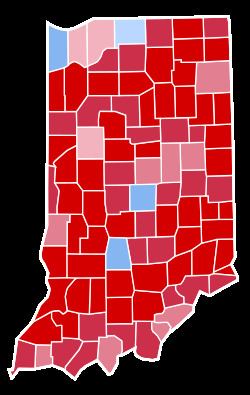November 8, 2016 2020 → 11 0 56.9% 37.8% | Turnout 58.00% 1,557,286 1,033,126 Date 8 November 2016 | |
 | ||
Trump
40-50%
50-60%
60-70%
70-80% Clinton
40-50%
50-60% | ||
The 2016 United States presidential election in Indiana was held on November 8, 2016, as part of the 2016 General Election in which all 50 states plus The District of Columbia participated. Indiana voters chose electors to represent them in the Electoral College via a popular vote pitting the Republican Party's nominee, businessman Donald Trump, and running mate Indiana Governor Mike Pence against Democratic Party nominee, former Secretary of State Hillary Clinton and her running mate, Virginia Senator Tim Kaine.
Contents
On May 3, 2016, in the presidential primaries, voters expressed their preferences for the Democratic and Republican parties' respective nominees for President.
Donald Trump won the election in Indiana with 56.9% of the vote. Hillary Clinton received 37.9% of the vote. Indiana is the home state of Trump's running mate Mike Pence, which was believed to have provided important assistance to the Trump campaign in what already would have been a Republican-leaning state.
Democratic primary
Two candidates appeared on the Democratic presidential primary ballot:
Republican primary
Twelve candidates appeared on the Republican presidential primary ballot:
Analysis
Indiana, despite voting Democratic once for Barack Obama in 2008, has shifted back to being solidly Republican. Republican nominee Donald Trump carried the state by 19 points over Democrat Hillary Clinton, thus gaining all of Indiana's 11 electoral votes.
Donald Trump's victory in the Hoosier State can be attributed to several factors. For one, Donald Trump had selected Indiana governor Mike Pence as his running mate, effectively eliminating any chance that Clinton could repeat Obama's surprise upset win in the state over John McCain eight years prior. Also, the state skews whiter and more Evangelical Protestant than the rest of the Midwest and the Rust Belt overall, which is a better demographic make-up for Republicans; Trump won white born-again and Evangelical Christians by a margin of 75-22.
Suburban communities in the "doughnut counties" surrounding Indianapolis lean heavily Republican, and bolstered the Trump-Pence ticket in the state. Many of these voters are fiscally conservative and family-oriented. Another G.O.P. stronghold that benefitted Trump was the northeast region around Fort Wayne, which is a mix of suburban, exurban and rural areas, and is home to some of the most socially conservative voters in the nation.
In Southern Indiana along the Ohio River, especially around Evansville in Vanderburgh County, the electorate is dominated by “Butternut Democrats:" socially conservative, working-class white voters who were Democrats for generations but have been trending Republican. Such voters turned out for Trump in full force, inspired by his economic populism and by Pence's social conservatism.
Trump also won in Vigo County, home to Terre Haute and a noted bellwether; it has voted for the winner of every presidential election all but twice since 1892.
Clinton, for her part, performed well in Indianapolis in Marion County and in Gary in Lake County, which has a large African American population and is considered part of the Chicago Metropolitan Area. Clinton won African Americans by a margin of 83-12.
